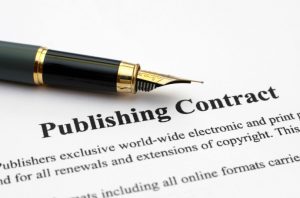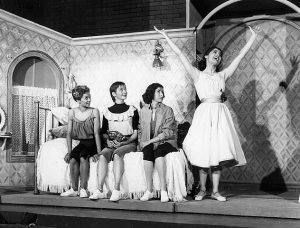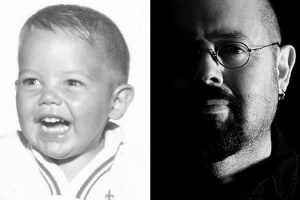RESEARCH
This post is about series of vicious murders, a class I conducted on how to fictionalize such horrific events, and a student who taught me something important in the process.
This all took place late last month at the Book Passage Mystery Writers Conference in Corte Madera, California. For the past several years, I and fellow faculty member George Fong—former FBI Special Agent, now security head for ESPN and a novelist himself—have conducted a class where we take a criminal case, outline the facts, and then ask the participants how they would go about fictionalizing the material. The past two years, we’ve added Jim L’Etoile to the mix, a longtime veteran of the criminal justice system (he’s the son of prison warden)—and, you guessed it, he too is a novelist.
George, given his law enforcement background, has normally led the way by presenting the case; Jim and I have then led a group discussion on how to approach what George has presented as source material for fiction, asking such questions as: Who is the protagonist? Should there be a narrator? Who should have POV status? Where should the story begin? When should the identity of the criminal(s) be revealed? How will answers to these questions fundamentally change the tone, pacing, and dramatic tension of the narrative?
In the past, George has presented cases he has personally worked on, including the Yosemite murders and a Russian mafia kidnap-extortion case out of Los Angeles.
This year, however, he decided to look beyond his own experience and instead present a headline-grabber that many of the conference participants would surely know about: the Golden State Killer case.
George reached out to Steve Kramer, an attorney who previously worked in the FBI’s Los Angeles office, who, despite not being a field agent, turned out to be instrumental in identification and apprehension of the criminal in question, Joseph Deangelo. He simply took it on himself to solve the case which, at the time he got involved, had lain dormant for years. He specifically worked closely with Contra Costa Sheriff’s Detective Paul Holes, who had responsibility for several open cases believed to be linked to the suspect then already identified by the moniker the Golden State Killer.
[Note: Though Michelle McNamara’s incredible true crime book, I’ll Be Gone in the Dark: One Woman’s Obsessive Search for the Golden Gate Killer came out not long before law enforcement identified and arrested Deangelo, it did not, as some believed, point investigators to him as a suspect. Their work, which relied largely on DNA evidence, was independent of McNamara’s.]
During our workshop, George laid out the most salient facts of the case for the participants in a Power Point presentation:
Read More
Painting of Dido Elizabeth Belle (l) and her cousin Elizabeth Murray (r), circa 1778
I start this call to action with a confession. I began writing my first historical novel, The Magician’s Lie, around 2009. After multiple rewrites, working with my agent and an outside editor, we finally sold the novel to Sourcebooks in 2013. After more work and more rewriting, the book was published in January 2015. I estimate I must have done no fewer than 10 complete revisions, in which I overhauled nearly every aspect of the story: plot, character, timeline, scene breaks, chapter breaks, language, perspective, and countless other elements of the novel.
And at no point during that process do I ever remember thinking, You know, maybe there should be a character in this book who isn’t white.
Now, this seems vaguely ridiculous. White privilege is a reason, not an excuse, and as an American-born white writer I have benefited from that privilege. I’ve had the luxury of not thinking about things like, oh, whether this aspect of my writing reflected either today’s world or the world in which my story was set. I haven’t had to consider whether agents or editors will be interested in stories about people who look like me: overwhelmingly, they look like me.
If you’ve been following publishing at all, you probably know there’s an active, powerful #ownvoices movement advocating for stories in which the protagonist and the author share a marginalized identity. And that’s awesome.
What I want to advocate for here is something different. Not every writer is equipped to take on a book with a marginalized protagonist; not everyone has that kind of story to tell. As allies, white writers can support, promote, purchase and read stories that bring racial and ethnic diversity to the fore. Same goes for stories from other marginalized communities and identities. Find them, love them, talk about them. It’s all the same stuff we ask our readers to do for our stories; it’s the least we can do to encourage stories we want to see in the world.
So if I’m not advocating writing stories from communities outside the mainstream, what do I want historical fiction writers who look like me to do?
More work. More research. Look, I know there’s already a lot. We’re spending hours looking up the menu at Delmonico’s in 1905 and finding exactly the right smart cloche for our fashion-forward 1923 flapper to slap onto her head. We’re digging up slang, addresses, music, architecture and more. The best historical fiction pulls the reader into a world so well-drawn it feels like we’re there with the characters, seeing and tasting and touching that world.
And if you haven’t considered that not every face in that world you’re writing about is white, it’s time to consider it.
I use “white” as shorthand in that sentence but it’s about far more than race, obviously. Neurodiversity. Disability. Gender expression. So much more. People with marginalized identities have always existed; history books and Hollywood have created the illusion that they didn’t. Especially in the past few years, historical fiction has become a key tool to make the untold stories […]
Read MorePlease welcome back Alma Katsu to Writer Unboxed today! Alma is the award-winning author of THE HUNGER, a reimagining of the story of the Donner Party and one that Stephen King has called “Deeply, deeply disturbing.”
Additionally, THE HUNGER was on NPR’s list of 100 favorite horror stories, was named one of the best books of 2018 by Barnes & Noble and Amazon, and was just named a Bram Stoker Award finalist! It released in paperback two days ago, on March 5th.
Her debut novel, THE TAKER, was one of Booklist’s Top Ten Debut Novels of 2011.
Learn more about Alma on her website and by following her on Twitter.
Tips for Complex Historical Research
Is America afraid of doing research?
That’s the question I had to ask after touring for release of The Hunger, a reimagining of the story of the Donner Party with a horror twist. The question I was asked the most at events, hands down, was how did I manage the research for the book?
Why this horrified fascination for research? Were we all scarred writing research papers in high school?
I admit that the amount of research required for The Hunger was pretty daunting, but that’s because it wasn’t merely set in a historic period, it was about a specific and well-known historical event. It had to follow the actual route and timeline, and it also had to cover a huge cast of characters (there were roughly one hundred people in the wagon party, including children). I joke that there are, easily, ten thousand facts tucked throughout the book and that might be a conservative estimate.
Luckily, I was prepared: I’ve been a professional researcher for over 30 years. I’ve found it’s well-suited for historical fiction, maybe even more so than historians. The difference between historians and researchers is that researchers are trained to sift through information surrounding a subject quickly and efficiently in order to make logical sense of it and reduce it to its essential elements, while retaining integrity of all the facts.
Based on questions I’ve been asked, the two main problem areas for most writers seem to be: (1) How do you know when to stop gathering information (“help me, I can’t stop researching”) and (2) How do you organize and manage your notes? I firmly believe you don’t have to read everything that was ever written on your subject before you can start writing. However, you do need to have a sense of what you need to know and the discipline to trust your judgment.
A few tips to bear in mind:
Read MorePublishing contract
Recently, I presented a research paper at a publishing conference which was themed around the experience of negotiating, and signing, book contracts. The paper, based on a series of interviews with Australian-based authors, publishers and agents, looked at all kinds of questions around book contracts. One of the questions which aroused a lot of interest was the idea of the contract ‘red line’—when do you know, whatever side of the publishing table you’re on, that you need to walk away? I thought WU readers might be interested to read some of the things people said.
General comments:
All publishers and all creators are different, but they all need to be able to communicate clearly with each other. If a creator is uncomfortable with discussion at the contract stage, this is a good time to consider whether there is a good fit with the publisher (publisher).
The time to walk away is when an author or publisher comes to believe they won’t be able to sustain a positive relationship any longer, because if you can work together and communicate effectively then there may still be a way forward, regardless of the written contract (author).
I think you should walk away if you feel unduly pressured into making decisions that you are not comfortable with. Perhaps another publishing house may suit you (publisher).
If the publisher won’t negotiate on something important to you, don’t sign. Once you sign the contract you’re bound by it, no matter how unfair it is. Authors have more options than ever before to get published, so just walk away (author).
What about specific ‘red lines’? These ranged from:
Read MoreMy last post discussed nonverbal communication (gestures, expressions, posture) as a means of making scenes stronger, less repetitive, and more immediate. This blog will explore how non-verbal communication provides a means of incorporating backstory seamlessly and integrally into a work of fiction.
Backstory–where the characters have come from, what they have experienced, how they have successfully or unsuccessfully reacted to their past context–is an essential, critical, and desperately difficult element of successful storytelling. Done poorly—in ‘data dumps’, tell-all prologues, or extensive and jarring flashbacks–it pulls the reader backwards, out of the motion of the story and into a closed off past. Done well—integrated into the story–it pulls the past forward, providing clues to the way a character’s past experiences and disappointments influence present choices, actions, and mistakes.
How to integrate backstory into the story present is neither obvious nor easy. There are many writerly devices to do so—through direct communication (characters discussing the past, a character’s internal self-examination, or a narrator’s overview); through discovered records (letters, diaries, photographs), through story consequences from past actions (scars, physical injuries, institutionalization). Many of these devices require a good deal of finesse to make them a believable part of the story rather than a ‘plant.’ Would those characters really have had that conversation about the past? How convenient that the letter explaining everything was found within two pages of the conclusion. Readers are smart, and any time these writerly devices start to feel like authorial manipulation—a lazy means of communicating story information–rather than an integral part of the story, the reader loses a little faith.
Nonverbal communication–which is based on learned, repeated, or automatic responses developed from past experiences–provides a powerful story tool for connecting the present to the past in a manner that can minimize this sense of manipulation. Nonverbal communication offers immediate, visceral information to the reader; often information that the character would not willingly tell; and always information that brings the past into the present. This makes it possible for a writer to incorporate backstory as a part of the present story action, without resorting to exposition, explanation, or ‘telling.’
When a nonverbal reaction is normal, when it matches expectations, it is close to invisible. When it is unexpected or inappropriate it is glaringly visible and creates powerful story questions. Readers (and other characters in the story) instinctively understand that anomalous reactions require examination and explanation. Imagine a character whose reaction to a friend’s tear-filled apology is narrowed eyes and crossed arms. Why did she do that? The reader will typically assume that the answer lies in the character’s past–that at some point her unconventional reaction was a successful response, not an awkward one.
Emojis (which are literally a graphic alphabet of non-verbal communication) demonstrate the visceral power of inappropriate nonverbal response. Have you ever left the ‘wrong’ emoji in reaction to a text or a post? A thumbs up on a friend’s announcement of a deceased pet? A crying emoji when everyone else’s emoji is angry? Have you ever felt like you need to explain that discrepancy? Or delete it? Or edit it? That is the power of the unexpected response.
Read MoreThe last time I edited some of my work, I was dismayed to discover how many times my characters smiled, sighed, or scowled and how infrequently they used any other gestures. What, I thought, if my characters didn’t just smile, sigh, and scowl? What if they clapped hands and skipped around the room beaming? Or thumped down with a huge outrush of air, to settle in for the long tedious wait? Or leaned threateningly in towards the bully, elbows out, legs stiffened, features frozen? What if my characters could gain a much more nuanced, much more expressive range of gestures and emotions?
As I contemplated fancying up my emotional descriptions, I remembered Keith Cronin’s sage advice about pretentious words and had a reality check. Was I just getting carried away with word-love again?
Then I adopted a former stray dog, and my eyes were opened. She entered the house fully formed, with her own expectations, habits, and history. All I had to go on to figure out what she wanted or needed were her facial expressions, subvocalizations, and posture. I learned the subtle nuances of one dog ear raised, a short whine, a long whine, a big sigh. Figuring out what she was trying to ‘tell’ me had a big payoff (no messes, less chewing of items, a happy dog). This close observation became a habit, and I started watching people in everyday conversations.
Just how much of what is ‘said’ does not occur through words is astonishing. Researchers have estimated that more than half of communication (estimates range from 65% to 90% by various investigators) is non-verbal. The same words will mean different things depending on tone of voice, accompanying facial expression, posture and position of the speaker, even clothing and appearance. First impressions happen within 1/10th of a second. Or less. And they are mostly based on non-verbal communication.
There has been a lot written on non-verbal communication–even Charles Darwin wrote a book about it. (Links to a few more recent studies can be found at the end of this blog.) A lot of current research appears in psychology studies, an equally large amount appears in guides to business success, since non-verbal communication is a crucial part of making presentations and deals. I found surprisingly little written on the glorious possibilities it offers for writers of fiction. A simple summary of the characteristics of non-verbal communication reads like a checklist of strategies for improving flat scenes:
Non-verbal communication:
I recently stumbled onto an online discussion about animated films, where somebody referred to The Lion King as having been inspired by Shakespeare’s classic play Hamlet. That was news to me, and it made me think about other films that I had belatedly learned were inspired by Shakespeare plays, such as 10 Things I Hate About You (The Taming of the Shrew) or My Own Private Idaho (Henry IV and Henry V).
This in turn got me thinking about how little I actually knew about Shakespeare. True confession: until about four months ago, my Shakespearian awareness was largely limited to a 1966 episode from season 3 of Gilligan’s Island, where the castaways perform a musical adaptation of Hamlet for a famous movie producer currently stranded on their island (hey, it could happen). Behold, in all its glory:
Boning up on the Bard
While I’ll admit that episode is fondly etched into my cultural DNA (yes, I’m deep), I realized I needed something more. After all, now that I am supposed to be a Serious Writer (said with the appropriately furrowed brow, and the sincere intent to someday purchase a tweed blazer with leather elbow patches), this scarcity of SSC (Shakespearian Street Cred) seemed inexcusable. So I took advantage of some recent time off from the DDG (dreaded day gig) to remedy this gap in my cultural literacy, and went off to my local library to load up on books and DVDs. I tend to be a total-immersion kind of guy when I develop a new interest, so the next several weeks were all Shakespeare, all the time. The results were illuminating. First, there was the fundamental question:
Just how big a deal is this guy?
Pretty darn big, as I was soon to learn. As literary critic and expert on all things Shakespearian Harold Bloom observes in the forward of Susannah Carson‘s book, Living with Shakespeare: Essays by Writers, Actors, and Directors, Shakespeare is “the most widely read author in English; his Complete Works are second in popularity only to the Bible.” (Take that, James Patterson! Suck it, Clive Cussler! But I digress…)
Okay, so the guy’s a best-seller. But Shakespeare’s impact is broader and more profound than the sheer size of his readership, as Bloom elaborates:
We live in Shakespeare’s world, which is to say that we live in a literary, theatrical, cultural, and even psychological world fine-tuned for us by Shakespeare. Had he never lived, we would have bumbled along well enough, but he did live, and he did write, and those works were printed, and read, and performed, and passed on, and read some more, and performed some more, and emulated, and assimilated, and quoted, and so on. So that now, four hundred years later, we continue to read and perform and emulate his work so thoroughly and passionately that it’s difficult to conceive who we would be – as a culture, as ourselves – had Shakespeare never existed.”
Those are some powerful claims, and worthy of further examination.
Read MorePlease welcome Jim Dempsey back to Writer Unboxed today! Jim is a professional member of the Society for Editors and Proofreaders and works as a book editor at a company called Novel Gazing. In his own words, Jim tells us that:
‘I’ve been editing for a little more than 20 years, gradually making the shift from nonfiction to fiction, which is where my heart really lies. After a few years, I was so busy editing novels that it made sense to pool resources with another two editing friends, and together we set up our own company called Novel Gazing. That was in 2012, and although I have continued with a few nonfiction clients, I spend most of my time editing fiction for publishers and self-publishing authors. I enjoy the challenge of fiction, making sure all the pieces fit together to make a perfect whole.’
You can learn more about Jim and his services on his company website, and by following him on Twitter (@jimdempsey and @novel_gazing).
How to Keep Track of All Your Novel’s Details
I recently worked on a story that had two Mondays in the same week. When I pointed this out, the author was so embarrassed to have made such an obvious error, but it’s a simple mistake to make. Raymond Chandler apparently forgot to reveal who killed the chauffeur in The Big Sleep, and one character in The Iliad was still around to witness his son’s death even though Menelaos had killed him much earlier.
It’s those minor characters that are usually the problem. The little details. You know your main characters perfectly, you can see them in your mind’s eye. But was her mother born before the war or just after? Did he meet his first wife when he was a freshman or was he already a sophomore?
Editors have a similar problem when they start to work on your book. They don’t know anything about your characters, the world they live in, who did what or when, but they still have to keep track of it all. They have to be able to point out that John, who had a bad limp in chapter 3, is now escaping over back-yard fences like an Olympic hurdler or remind you that the witness spoke with a heavy British accent when she was first interviewed but sounds more like a Southern belle when the inspector revisits her later in the book.
Keeping track of all of these details and idiosyncrasies is essential for the editor, and it’s useful for authors too to make sure your characters, settings, style, and backstories are consistent.
Avoid confusion
Having two Mondays in the same week and other issues with your story’s timeline in particular can be time-consuming errors to correct. It can mean that everything after that blip gets knocked out of sync too. And a simple find-and-replace to change every Monday to Tuesday won’t work as you then have to change every Tuesday to Wednesday and so on, plus check for every mention of ‘yesterday’ and ‘tomorrow’ and ‘day before’ too.
More importantly, a disturbed timeline can confuse readers: ‘I thought the murder happened on Monday, but now she’s saying today is Monday.’ […]
Read MorePlease welcome Lydia Kang, author of several books, including the newly released Beautiful Poison, to Writer Unboxed today!
Lydia is a physician and author of fiction, poetry, and non-fiction. She was born in Baltimore, Maryland and graduated from Columbia University and New York University School of Medicine. She completed her residency and chief residency at Bellevue Hospital in New York City and currently lives in the midwest, where she continues to practice internal medicine.
Beautiful Poison, set “just beyond the Gilded Age, in the mist-covered streets of New York,” demanded that Lydia research many things, from Spanish influenza, poisons and more–a skill set she’ll share with us today.
“Writing historical fiction requires a certain amount of passion, but passion only gets you so far in the research process,” said Lydia. “I wish I’d had a list like this to help me when I started writing historical, so I’m happy to share the neater version of the chaotic process I had to figure out myself!”
You can learn more about Lydia and Beautiful Poison on her website, and by following her on Twitter and Facebook.
Historical Novels—Your Research To-Do List
Before I wrote A BEAUTIFUL POISON, my historical mystery novel, I’d fallen in love with the year 1918. The Gilded Age was ending and the roaring twenties had yet to even purr. I’d wanted to include true events in my story—the emergence of the Office of the Chief Medical Examiner at Bellevue Hospital; the worldwide influenza epidemic; the horrors of World War I, and the infamous poisoning of the radium girl dial painters.
It was an enormous task, but this is how I got my history work done so I could tell the story of Allene, Jasper, and Birdie with confidence.
Start with historical nonfiction. Go for award-winning nonfiction books that depict people, places, and events. I read books that were beautifully researched and entrancingly entertaining. A choice few were Deborah Blum’s THE POISONER’S HANDBOOK and John M. Barry’s THE GREAT INFLUENZA.
Poach bibliographies. If nonfiction books are the trees, bibliographies are the roots. Dig deep, but be wary of interesting yet haphazard side trips that aren’t helpful for the task at hand. I used Archive.org often, which has free online books from the last several centuries.
Fall down the Google/Pinterest black hole. Then dig yourself out. Everyone does it! Some advice, though:
Read historical fiction…carefully. An obvious instinct is, “How did other authors do this?” But remember, novelists don’t always get things right. Excellently researched novels are a complement to your research, not a substitution. They are fiction, after all. Unless…
Read MoreFlickr Creative Commons: Bruce Guenter
An interesting thing has been happening to me with increased frequency: I’ve been asked to read friends’ and acquaintances’ manuscripts as a sensitivity reader for stories that deal with immigration. Because I am a Latina and an immigrant, and the authors who’ve requested I read their work are writing outside of their own experience, I’ve been asked to evaluate their work for authenticity. So far, I’ve had to turn down these kinds of requests because I’ve been busy with my own writing and mentoring work, not to mention personal commitments. But while I am not actively offering sensitivity reading as a service, there are several writers and editors who are. As sensitivity readers become more sought after in the publishing world, their role has been met with mixed reactions.
First Things First: What Is a Sensitivity Read?
A sensitivity read is an evaluation of a manuscript, usually one that touches upon characters and experiences of a marginalized group of people, that is performed by someone within that group to bring attention to potential inaccuracies, biases, and reinforcements of harmful stereotypes. Much like one might ask a cardiologist to read their story about a cardiologist for accuracy, a sensitivity read helps ensure that the portrayal of characters and worlds unknown to the author ring true. But more than that, it helps authors better yield the immense power and responsibility of their words. How many of us write because we want to make sense of the world around us? And more importantly, how many readers seek out our work in search of stories and truths that will, inadvertently or not, shape how they see the world?
This kind of work takes, well…work, at every stage of the process. There’s pre-writing research, there are revelations we experience during the writing itself. Post-writing, a sensitivity read provides yet another crucial layer of learning to the process. And yet, some authors continue to resist (and resent) the very idea of one.
Maybe it’s the name. The word “sensitive” has gotten a bad wrap lately, too often used to accuse someone of being too touchy or emotional. Perhaps the real question writers should be asking is: am I being sensitive enough? Am I using my senses to foster acute awareness and concern for the complexities of what I’m writing about? Isn’t that part of our job as writers?
Maybe it’s how it’s described. A recent story titled “Publishers are hiring ‘sensitivity readers’ to flag potentially offensive content” included an unfortunate word choice in the headline alone. The main purpose of a sensitivity read is not to avoid offending; it’s to avoid harming. If you’re writing about a person who is marginalized or underrepresented, understand the weight of what that means—for readers who rarely see their experiences reflected in books, seeing negative or erroneous stereotypes reinforced can be hurtful to them and their community. For readers outside of that experience, yours may be one of the few stories about a disabled or gay or black person that they read for years. Books carry authority; they have a way of seeming […]
Read More




















